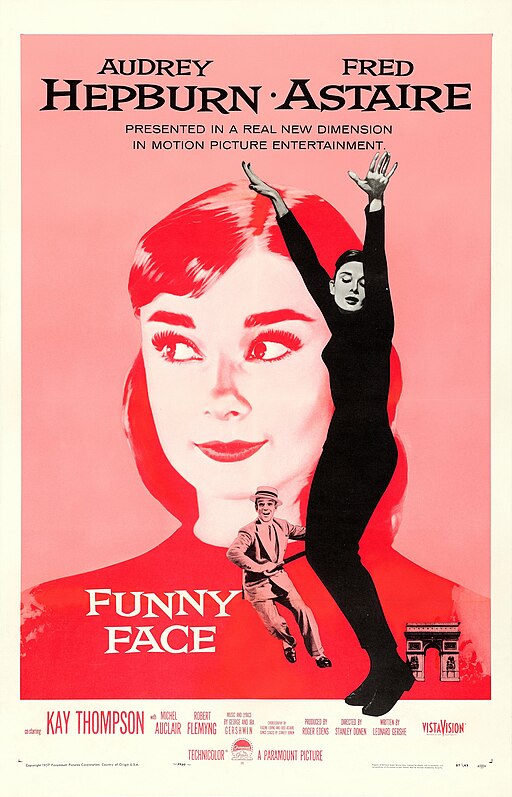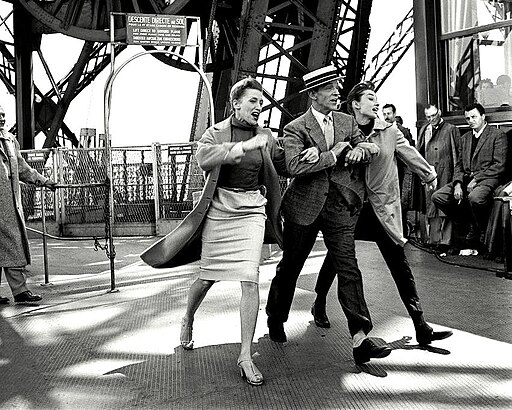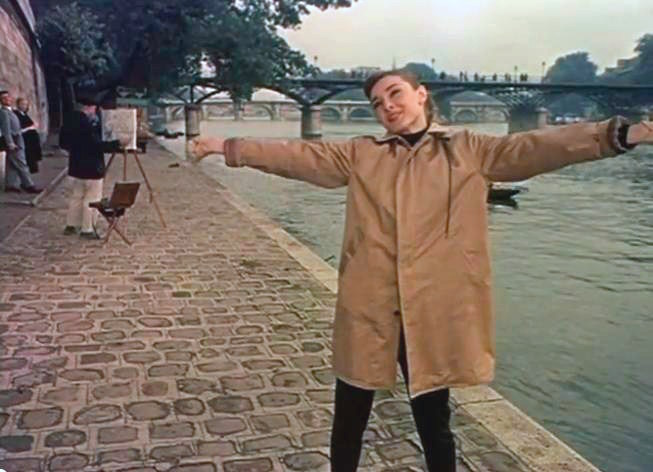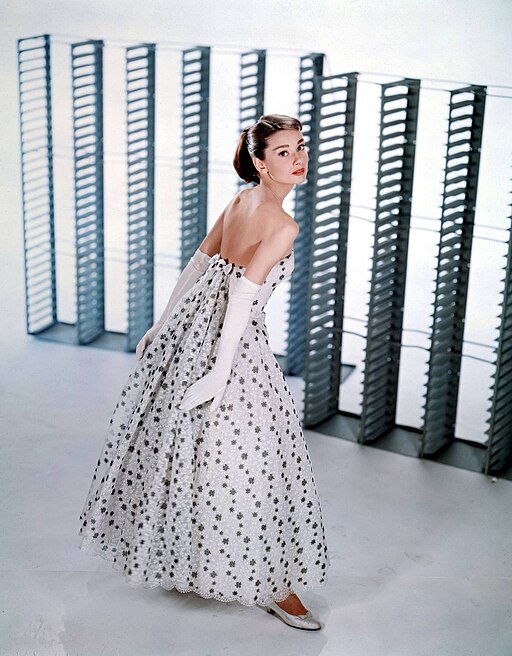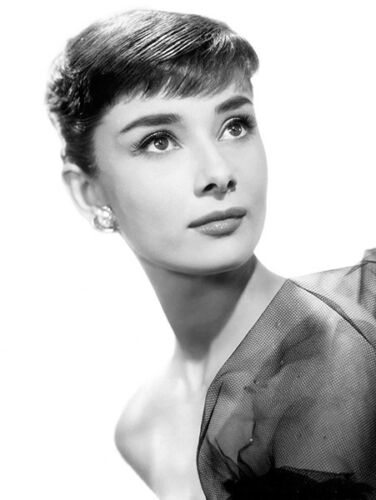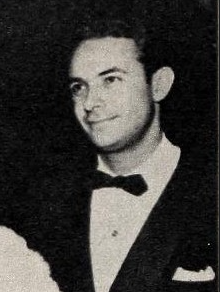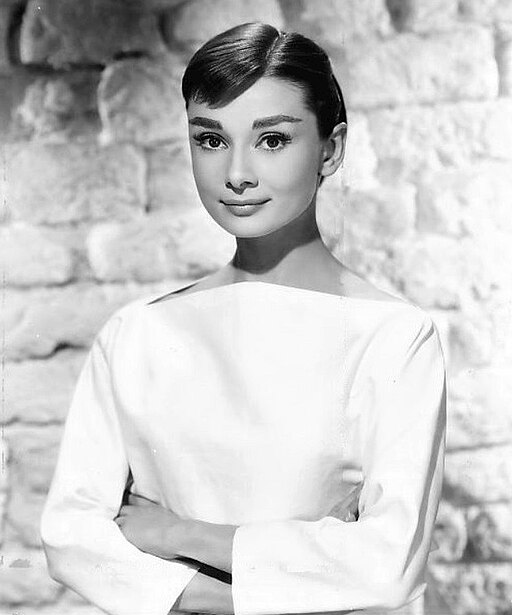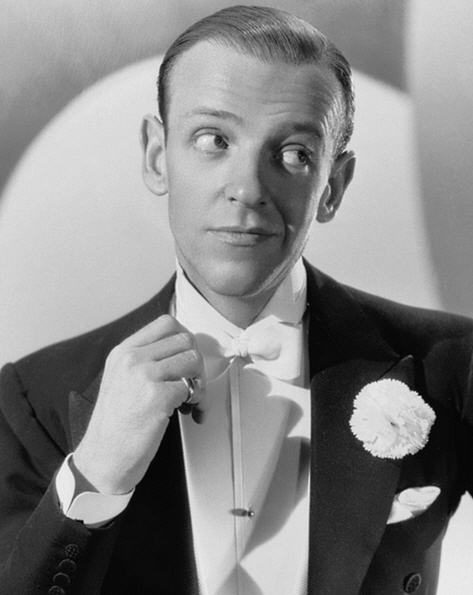Funny Face - 1957
back| Released by | Paramount Pictures |
| Director | Stanley Donen |
| Producer | Roger Edens |
| Script | Leonard Gershe |
| Cinematography | Ray June |
| Music by | George Gershwin (music), Ira Gershwin (lyrics), Roger Edens (additional songs) |
| Running time | 103 minutes |
| Film budget | $3 million |
| Box office sales | $4.9 million |
| Main cast | Audrey Hepburn - Fred Astaire - Kay Thompson |
Funny Face
An Enchanting Musical that blends Romance and Fashion
Funny Face is a musical film set in the fashion world of Paris. It combines elements of romance, comedy, and glamour with iconic performances by Hepburn and Astaire.
The film is notable for its rich visuals, memorable Gershwin scores, and sophisticated choreography, showcasing Donen's skillful direction.
Related
Funny Face – 1957
Summary and Analysis
"Funny Face" (1957) is a charming blend of fashion, romance, and music, directed by Stanley Donen. The film is set against the backdrop of the high-fashion world in Paris, and it stars Audrey Hepburn and Fred Astaire as the leading characters, bringing a mix of elegance and talent to the screen.
Summary
"Funny Face" tells the story of Jo Stockton (Audrey Hepburn), a bookish young woman who works in a Greenwich Village bookstore. Her life takes an unexpected turn when fashion photographer Dick Avery (Fred Astaire), modeled after real-life photographer Richard Avedon, scouts her bookstore for a high-fashion shoot. After a chaotic photo session, Avery is struck by Jo's unique look and decides she is the perfect model for a new marketing campaign for the fashion magazine "Quality," run by the demanding editor Maggie Prescott (Kay Thompson).
Despite her initial reluctance, Jo agrees to go to Paris as part of the deal when she learns she'll have the chance to meet her intellectual idol, Professor Emile Flostre (Michel Auclair). In Paris, Jo is transformed from a shy bookstore clerk into a top model, wearing dazzling couture outfits and participating in iconic photo shoots across the city—including singing and dancing in a memorable sequence at a Parisian café.
As the shoot progresses, Jo and Dick grow closer, and their professional relationship evolves into a romantic one. Throughout the story, the film explores themes of beauty, intellect, and the convergence of high culture and pop culture. Eventually, Jo must decide what is more important to her: a career as a fashion icon or following her philosophical pursuits.
Analysis
"Funny Face" is noteworthy for its innovative integration of fashion and cinema. The film features extensive scenes set in actual Parisian locations, including the Louvre and the Champs-Élysées, which adds a layer of authenticity and grandeur to the visual experience. The cinematography by Ray June captures the elegance of Paris and the vibrant energy of the fashion industry with vivid colors and dynamic compositions, enhanced by the use of Technicolor.
The musical score, featuring songs by George and Ira Gershwin, adds a lyrical and romantic quality to the film. Songs like "How Long Has This Been Going On?" and the energetic "Think Pink!" are not only entertaining but also serve to advance the plot and deepen character development.
Audrey Hepburn's performance is particularly notable for how it blends her known fashion icon persona with a more comedic and quirky character. Her transformation throughout the film reflects a broader commentary on the fashion industry's power to manufacture and redefine beauty standards.
Fred Astaire brings his trademark charm and incredible dancing ability to the role of Dick Avery. His interactions with Hepburn are filled with a genuine sense of camaraderie and affection, making their age difference seem inconsequential within the story's romantic fantasy context.
Overall, "Funny Face" is a celebration of beauty, both in its human and cityscape forms, and a film that cleverly critiques yet indulges in the very fashion industry it portrays. It remains a timeless piece for its artistic and cultural significance in both the worlds of film and fashion.
Classic Trailer of Funny Face 1957:
Full Cast:
- Audrey Hepburn as Jo Stockton
- Fred Astaire as Dick Avery
- Kay Thompson as Maggie Prescott
- Michel Auclair as Professor Emile Flostre
- Robert Flemyng as Paul Duval
- Dovima as Marion
- Jean Del Val as Hairdresser
- Virginia Gibson as Babs
- Sue England as Laura
- Ruta Lee as Lettie
- Alex Gerry as Dovitch
- Iphigenie Castiglioni as Armande
- Suzy Parker as Specialty Dancer (uncredited)
Analysis of Stanley Donen’s Directing Style:
Stanley Donen's direction in "Funny Face" (1957) is a testament to his exceptional ability to blend musical, romance, and comedy genres into a visually compelling and entertaining film. Donen, known for his work on other classic musicals such as "Singin' in the Rain" and "On the Town," brings a distinctive flair and a deep understanding of musical cinema to "Funny Face."
Visual Style and Cinematic Techniques
Donen’s use of color and innovative cinematography in "Funny Face" stands out prominently. He effectively utilizes the vibrant Technicolor palette to enhance the visual allure of the Paris setting and the haute couture fashions that define the film’s aesthetic. The color red, for instance, is used strategically throughout the film to draw attention to key elements and to convey emotional undercurrents.
His camera work is dynamic, employing a variety of angles and movements that bring energy and a modern feel to the dance sequences and fashion shoots. The famous bookstore scene, where Jo is first discovered, showcases Donen's skill in choreographing complex camera movements that complement the physical comedy and chaos of the scene.
Choreography and Musical Integration
Donen's background as a dancer and choreographer shines through in how seamlessly he integrates dance and music into the film's narrative. The dance sequences are not just performances but pivotal moments of character development and plot advancement. For example, the dance sequence in the Parisian café, where Jo expresses her newfound confidence and joy, is both a showcase of Hepburn’s charm and a critical turning point in her character’s evolution.
Collaboration with Cast and Crew
Donen's collaborative spirit is evident in his work with the cast, particularly with Audrey Hepburn and Fred Astaire. He was adept at harnessing Hepburn's elegance and vulnerability, allowing her to shine both as an actress and a fashion icon. Meanwhile, his history with Astaire allowed them to craft dance sequences that highlighted Astaire's strengths as a performer, making their scenes together resonate with genuine warmth and chemistry.
Thematic Depth
Under Donen’s direction, "Funny Face" delves into themes of beauty, intellectualism, and the intersection of high culture and popular culture. He handles these themes with a light touch, weaving them through the lighthearted plot without sacrificing the film's breezy tone. This approach allows the film to resonate on different levels, providing both surface-level entertainment and deeper, more reflective undercurrents about the nature of love and art.
Conclusion
Stanley Donen's direction in "Funny Face" is marked by a sophisticated visual style, masterful integration of music and dance, and a keen ability to work harmoniously with his cast and crew to create a timeless cinematic experience. His work not only showcases his technical skill and creative vision but also highlights his unique ability to elevate a genre film into a work of art that is both reflective and delightful. His contribution to the film is a crucial element of its enduring appeal and status as a classic in the American musical genre.
Perfect Performance of Audrey Hepburn:
Audrey Hepburn's performance in "Funny Face" (1957) is a captivating showcase of her range as an actress, blending her inherent charm and elegance with a strong comedic flair and emotional depth. Her portrayal of Jo Stockton, a bookish and somewhat naïve young woman who transforms into a sophisticated model, underscores Hepburn's ability to embody complex characters who are both relatable and aspirational.
Character Transformation
Hepburn's role as Jo Stockton requires a dynamic transformation—both physically and emotionally—which she manages with apparent ease. Initially presented as a reserved and intellectual bookstore clerk in Greenwich Village, Jo is skeptical of the shallow world of fashion. Hepburn convincingly portrays this initial skepticism, using subtle facial expressions and body language that convey her character's disdain for the superficial aspects of the modeling world.
As the film progresses, Hepburn's character undergoes a striking transformation. The moment Jo steps onto the Parisian stage, Hepburn seamlessly transitions into a glamorous and confident model. This change is not just in her appearance; Hepburn adjusts her posture, gait, and demeanor to reflect Jo's growing comfort and excitement about her new role. This physical and behavioral change is pivotal, demonstrating Hepburn's skill in depicting character development through non-verbal cues.
Comedic Timing and Dance
Comedy plays a significant role in "Funny Face," and Hepburn’s comedic timing is impeccable. She delivers Leonard Gershe's witty dialogue with a natural ease, bringing a light-hearted and playful energy to her scenes, especially in her interactions with Fred Astaire’s character, Dick Avery. Her ability to react and respond to slapstick elements and verbal sparring adds a delightful dimension to her character.
Moreover, Hepburn’s dance performances in the film further highlight her versatility. Although not primarily known as a dancer when compared to her co-star Astaire, she holds her own in their dance numbers. Her training in ballet is evident in the grace and precision of her movements, particularly in the famous beatnik dance scene in a smoky Paris café, where she combines modern dance with comedic elements, creating a memorable and defining moment in the film.
Emotional Depth
Throughout the film, Hepburn conveys a wide range of emotions, from joy to contemplation to romantic longing. Her interactions with the philosophical ideals she admires, particularly through her character's interest in empathicalism, are portrayed with sincerity and thoughtfulness. Hepburn’s ability to reflect Jo’s intellectual pursuits adds a layer of depth to the character, making her more than just a typical romantic lead. Her nuanced performance helps the audience sympathize with Jo's internal conflicts between her career ambitions, intellectual desires, and emerging feelings for Dick Avery.
Conclusion
Audrey Hepburn's performance in "Funny Face" is a testament to her exceptional talent as an actress. She brings depth, nuance, and charm to her role, making Jo Stockton a memorable and beloved character in the canon of classic cinema. Hepburn’s ability to navigate comedy, dance, and drama with equal proficiency ensures that her performance remains impactful, resonating with audiences long after the film ends.
Fred Astaire’s Performance Analyzed:
Fred Astaire's performance in "Funny Face" (1957) is a testament to his enduring talent and charisma as a leading man in musical cinema. Astaire brings his trademark sophistication, elegance, and extraordinary dancing ability to the role of Dick Avery, a fashion photographer inspired by real-life photographer Richard Avedon. His portrayal is pivotal in elevating the film, blending seamless dance choreography with a nuanced acting performance that balances professionalism and personal charm.
Mastery in Dance
Astaire's dance sequences are among the most memorable aspects of "Funny Face." His ability to convey emotion and narrative through dance is unparalleled. In each sequence, whether performing solo or with Audrey Hepburn, Astaire integrates his movements so fluidly into the storyline that each step seems to carry a piece of the narrative forward. His dances are not just exhibitions of technical prowess—they are integral to his character's interaction with Hepburn’s Jo Stockton, helping to develop their relationship from a professional to a romantic one.
One particularly striking example is the dance number in a Parisian café, where Astaire uses his dance to express and evoke joy, drawing Hepburn’s character into the performance and bridging their worlds of fashion and philosophy. His impeccable timing, combined with a style that is both precise and seemingly effortless, underscores the elegance and excitement of the fashion world portrayed in the film.
Acting and Character Depth
Astaire’s portrayal of Dick Avery shows a range of emotions, from his initial professional focus as a photographer looking for the perfect model to a more personal and vulnerable side as he develops feelings for Jo. Astaire’s performance is marked by a subtle warmth and gentle humor, which he conveys through facial expressions, tone of voice, and body language. He balances the character’s professionalism with a likable down-to-earth charm that makes him approachable and relatable.
His chemistry with Hepburn is palpable. Astaire manages to make their significant age difference almost irrelevant to their on-screen relationship, focusing instead on creating a connection based on mutual respect and shared passions. This dynamic is crucial in making their romantic relationship believable and endearing to the audience.
Vocal Performances
While primarily celebrated for his dancing, Astaire's vocal performances in "Funny Face" also contribute significantly to his character's appeal. His singing voice, characterized by its clear, light tone, suits the musical's romantic and whimsical style perfectly. Songs like "He Loves and She Loves" and "Funny Face" are delivered with a sincerity and gentleness that enrich the film's romantic storyline.
Conclusion
Fred Astaire’s performance in "Funny Face" showcases his multifaceted talent as both a dancer and an actor. He brings a depth to his character that transcends the conventional roles often found in musicals of the era, offering instead a portrayal that is both engaging and emotionally resonant. Astaire's role in "Funny Face" not only highlights his legendary skills in dance but also reinforces his capability to deliver a compelling dramatic performance, making his character a vital and unforgettable part of the film’s enduring charm.
Memorable Quotes from the Movie:
- Jo Stockton (Audrey Hepburn): "The only thing I ever studied was philosophy, and that just made me miserable."
- Dick Avery (Fred Astaire): "When I get through with you, you'll look like... What do you call beautiful? A tree. You'll look like a tree."
- Maggie Prescott (Kay Thompson): "Think pink! think pink when you shop for summer clothes. Think pink! think pink if you want that quelque chose."
- Jo Stockton: "I don't want to stop being me. I want to be better, but still me."
- Dick Avery: "Let's go back to the bookstore. I feel safe in the bookstore."
- Maggie Prescott: "Banish the black, burn the blue, and bury the beige! From now on girls... Think pink!"
- Dick Avery: "Now what's wrong with bringing out a girl who has character, spirit, and intelligence?"
Classic Scenes from Funny Face:
- Opening Number - "Think Pink!": This scene sets the tone for the entire movie, with Kay Thompson's character, Maggie Prescott, a fashion magazine editor, singing about the latest color trend in fashion. The vibrant, energetic performance by Thompson and the chorus, combined with a barrage of pink outfits and props, creates a visually striking sequence that satirizes the fashion industry's penchant for arbitrary trends.
- Bookstore Dance: When Dick Avery (Fred Astaire) and his team invade the quiet bookstore where Jo Stockton (Audrey Hepburn) works to shoot a fashion layout, chaos ensues. The scene is a blend of comedy and pandemonium, culminating in a moment where books fly off the shelves as Jo tries to protect her beloved store from the intrusive fashionistas.
- Philosophical Café: This scene is a key moment for character development and one of the most memorable in the film. Hepburn's performance of a spontaneous dance in a bohemian café in Paris highlights her character's transition from a reserved bookstore clerk to a more expressive and confident model. Her dance captures her newfound freedom and joy, symbolizing her evolution and the merging of her intellectual and fashionable sides.
- Photoshoots Around Paris: The series of photoshoots around Paris is visually stunning and serves as a love letter to the city itself. Locations include the Louvre, Champs-Elysées, and the Eiffel Tower. These sequences showcase not only the city’s beauty but also the evolving dynamic between Jo and Dick as they work together, with each photograph capturing a different aspect of Paris and Jo's growing comfort in her new role.
- The Romantic Ballad - "He Loves and She Loves": In this beautifully tender scene, Dick Avery confesses his feelings to Jo through the song "He Loves and She Loves" by George and Ira Gershwin. The scene is set against the romantic backdrop of the Seine River, with Astaire's charming performance and the serene setting enhancing the romantic mood. This sequence is a pivotal moment in their relationship, highlighting their deepening connection.
- Fashion Show Finale: The climax of the film features an elaborate fashion show where Jo Stockton models a series of stunning designer outfits. This sequence not only displays Hepburn's elegance and versatility as a model but also serves as the culmination of her transformation throughout the film. The fashion show is a dazzling display of couture fashion and is filmed with dynamic camerawork that captures the glamour and creativity of the industry.
Awards and Recognition:
Academy Awards (Oscars) - 1958:
- Nominated for Best Writing, Story and Screenplay Written Directly for the Screen (Leonard Gershe)
- Nominated for Best Cinematography (Color) (Ray June)
- Nominated for Best Art Direction-Set Decoration (Color) (Hal Pereira, George W. Davis, Sam Comer, Ray Moyer)
BAFTA Awards - 1958:
- Nominated for Best Film from any Source (USA)

